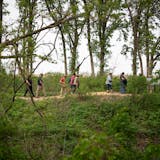About 81 percent of players in the NBA are people of color. In the NFL, about 73 percent. MLS, 54 percent. MLB, 43 percent.
Missing from that list: the NHL. Its numbers aren't as easily measured, as the NHL doesn't release players' racial backgrounds, saying it doesn't want those numbers taken out of context.
The NHL has been working on its diversity practices for nearly 25 years to overcome barriers such as hockey's cost and its accessibility in warmer climates where the sport is hard to find. The league also created a leadership position about a year ago to foster change around diversity and inclusion in both the NHL and hockey's grassroots. From building ball hockey courts in southern cities, to collaborating with USA Hockey, to educating youth players about the destructiveness of homophobic language and racial slurs, the NHL is invested in expanding its community.
But is it enough?
"It's kind of a tough question," Wild forward J.T. Brown said. "Yes, they're doing a good job. But there's always more that I feel like can be done."
The Wild hosted its "Hockey is for Everyone" theme night at its Monday home game, as part of an NHL-wide campaign to promote inclusivity. Several Wild players, for example, wrapped their sticks in rainbow LGBTQ pride tape for warmups on the ice. The league's stated goal for the campaign: to welcome people regardless of race, color, religion, national origin, gender, disability, sexual orientation or socio-economic status.
"I know if you look at the numbers of minority players in the NHL, people say, 'Oh, that's not many,' " said William Douglas, who runs The Color of Hockey blog about diversity in the sport. "… It's like a duck on the water. The duck looks like it's not doing anything. But check underneath. Well, he's paddling for all he's worth."
The Wild has three players of color: Brown and Jordan Greenway, who are black, and Matt Dumba, who is Filipino.
![Three weeks ago, Octavio Rodriguez switched from making transmission parts to casting parts for hospital bed brake assemblies at Twin City Die Castings. ] GLEN STUBBE • glen.stubbe@startribune.com Thursday, April 9, 2020 How employee-owned Twin City Die Casting, which just laid off 40 production workers of its 250 employees in what was supposed to be a good year, is trying to accelerate its pivot to growing medical parts business for ventilators, hospital beds, etc as it copes with instan](https://arc.stimg.co/startribunemedia/WNZYKGTZ5IYMUCO3KI5TR3N7WI.jpg?&w=80&ar=1:1&fit=crop)
djoles@startribune.com As boaters flock to Minnesota lakes and rivers this holiday weekend for the unofficial kick-off to the boating season, they'll face more inspections in and out of the water as local cities and counties ramp up their work to stop the spread of invasive species. Across the metro, more boat accesses will be staffed by watercraft inspectors thanks to $10 million funneled to county government programs this year, up from $4.5 million the state allocated last year. ORG XMIT: MIN1505222156290209 ORG XMIT: MIN1506021218440580](https://arc.stimg.co/startribunemedia/34QSKO44B2XKVNUZCO5SLJQSLY.jpg?&w=80&ar=1:1&fit=crop)

